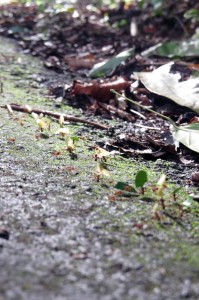Like all the other nights, this one also feels like a warm blanket around me. There has been little rain lately, so it’s not clammy. With my big backpack filled with field equipment I walk over the path, carefully holding my two speakers in my hands. The slope is steep, will I get my speakers down in one go? Carefully I balance, and then a small jump. I look back: how I’ll get them back up is a care for later.
I set up my new experiment (read here about my previous one). Speaker on one side, speaker on the other side. In this new experiment we investigate the influence of habitat on the predation preference of bats. Does vegetation affect the echolocation of bats? Aside from that, there is the suspicion that vegetation influences the amount of flies bothering the frogs. The speakers play the sound of the tùngara frogs (listen here), sometimes with vegetation on top of the speakers and other times without. With this experiment, we hope to see an interaction between vegetation and predation risk by bats or parasitic load by the bloodsucking flies. I put the cameras in their place, so they can be the silent witnesses of the visiting bats. The fly traps are ready to catch ignorant flies with their stickiness. Infrared lights, cameras, action! Continue reading
